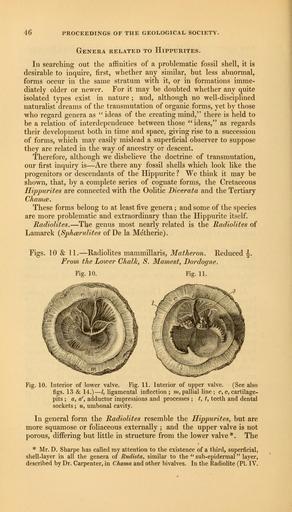MAKE A MEME
View Large Image

| View Original: | The_Quarterly_journal_of_the_Geological_Society_of_London_(12711328015).jpg (1828x3200) | |||
| Download: | Original | Medium | Small | Thumb |
| Courtesy of: | commons.wikimedia.org | More Like This | ||
| Keywords: The Quarterly journal of the Geological Society of London (12711328015).jpg 46 <br> PROCEEDINGS OF THE GEOLOGICAL SOCIETY <br> Genera related to Hippurites <br> In searching out the affinities of a problematic fossil shell it is <br> desirable to inquire first whether any similar but less abnormal <br> forms occur in the same stratum with it or in formations imme- <br> diately older or newer For it may be doubted whether any quite <br> isolated types exist in nature ; and although no well-disciplined <br> naturalist dreams of the transmutation of organic forms yet by those <br> who regard genera as ideas of the creating mind there is held to <br> be a relation of interdependence between those ideas as regards <br> their development both in time and space giving rise to a succession <br> of forms which may easily mislead a superficial observer to suppose <br> they are related in the way of ancestry or descent <br> Therefore although we disbelieve the doctrine of transmutation <br> our first inquiry is Are there any fossil shells which look like the <br> progenitors or descendants of the Hippurite We think it may be <br> shown that by a complete series of cognate forms the Cretaceous <br> Hippurites are connected with the Oolitic Dicerata and the Tertiary <br> ChamcB <br> These forms belong to at least five genera ; and some of the species <br> are more problematic and extraordinary than the Hippurite itself <br> Radiolites The genus most nearly related is the Radiolites of <br> Lamarck SphcBvulites of De la Metherie <br> Figs 10 11 Radiolites mammillaris Matheron Reduced \ <br> From the Lower Chalk S Mamest Bordogne <br> Fig 10 <br> Fig 11 <br> Fig 10 Interior of lower valve Fig 11 Interior of upper valve See also <br> figs 13 14 I ligamental inflection ; m pallial line ; c c cartilage- <br> pits ; a a' adductor impressions and processes ; t t teeth and dental <br> sockets ; u umbonal cavity <br> In general form the Radiolites resemble the Hippurites but are <br> more squamose or foliaceous externally ; and the upper valve is not <br> porous differing but little in structure from the lower valve The <br> Mr D Sharpe has called ray attention to the existence of a third superficial <br> shell-layer in all the genera of Rudisfa similar to the sub-epidermal layer <br> described by Dr Carpenter in Chama and other bivalves In the Radiolite PI IV 35614606 110213 51125 Page 46 Text v 11 http //www biodiversitylibrary org/page/35614606 1855 Geological Society of London NameFound Chama NameConfirmed Chama EOLID 10720381 NameBankID 2693785 NameFound Dicerata NameConfirmed Dicerata NameBankID 4141484 NameFound Hippurites NameConfirmed Hippurites EOLID 4773611 NameBankID 4195877 NameFound Radiolites NameConfirmed Radiolites EOLID 4773465 NameBankID 4326522 NameFound Radiolites mammillaris Biodiversity Heritage Library The Quarterly journal of the Geological Society of London v 11 1855 Geology Periodicals Smithsonian Libraries bhl page 35614606 dc identifier http //biodiversitylibrary org/page/35614606 smithsonian libraries Information field Flickr posted date ISOdate 2014-02-23 Check categories 2015 August 26 CC-BY-2 0 BioDivLibrary https //flickr com/photos/61021753 N02/12711328015 2015-08-26 20 52 18 cc-by-2 0 PD-old-70-1923 The Quarterly journal of the Geological Society of London 1855 Photos uploaded from Flickr by FĂŚ using a script | ||||